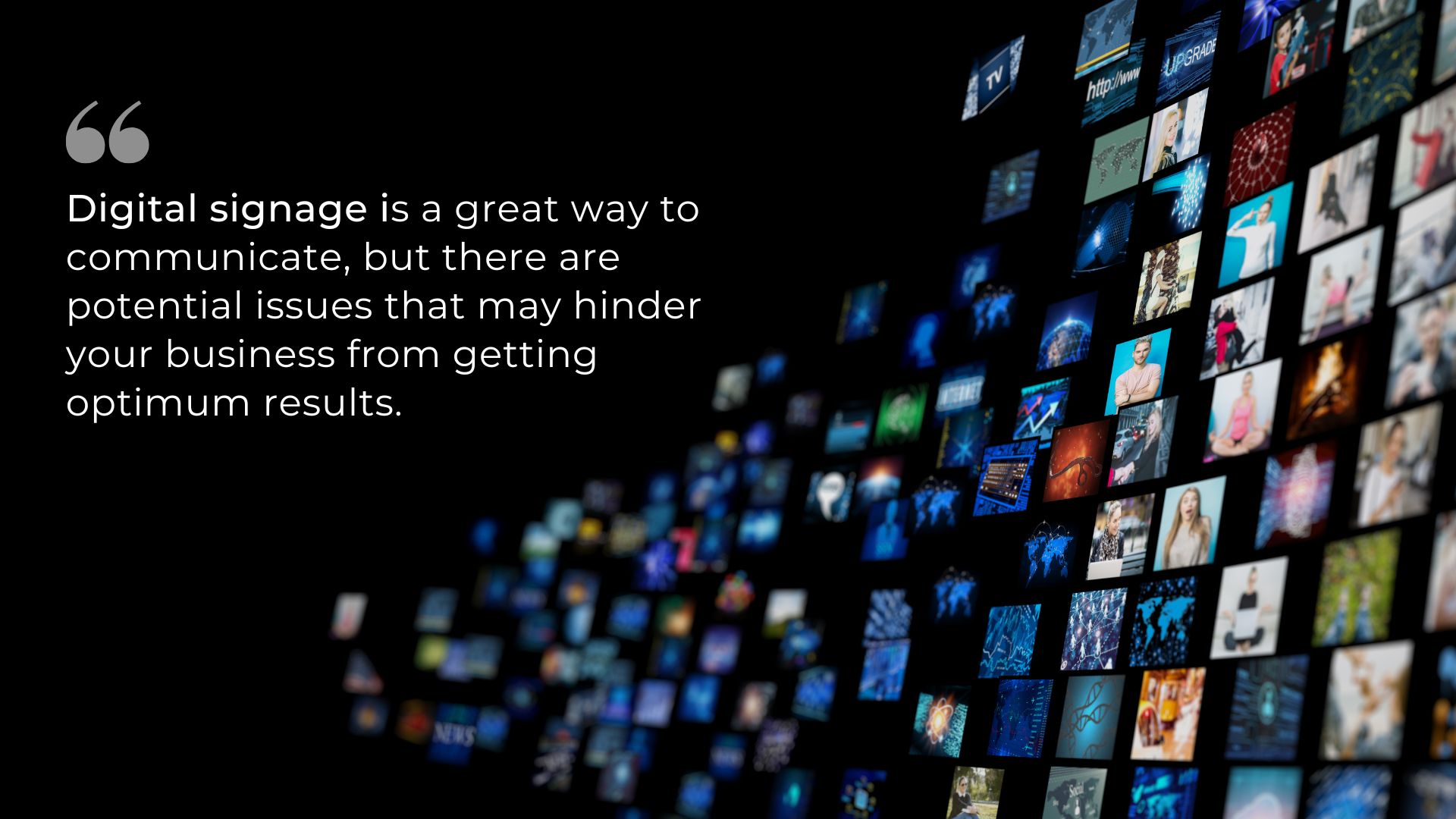Top 3 Digital Signage Problems and Solutions
by Scala Team
Top 3 Digital Signage Problems and Solutions
by Scala Team

Lack of Quality Content
Lack of quality content is a frequent issue that affects the success of digital signage. Factors leading to low-quality content include lack of understanding of your target demographic, poor design, lack of planning, and content that is obsolete or redundant. The risk of this is that your business can appear untrustworthy and your audience can lose confidence in your services.
Poor content quality is one of the most common digital signage problems. Poor content can be caused by:
- a lack of understanding of the target audience
- poor design
- lack of planning and
- outdated and repetitive content.
The risk you run with lacklustre or repetitive content is that your brand may appear unprofessional, and your audience may lose faith in your business as a result, as well as become bored with your content.
The fix:
Know your audience and brand
Be aware of who your target group is and understand your company’s brand identity to make relevant content. The visual design and the message of your content must be in sync with how your viewers envisage your brand.
Use good design principles
As outlined in this blog post, good design principles for digital signage include selecting the proper resolution and aspect ratio, using quality graphics and images, choosing the right typeface and text style and ensuring there is adequate contrast and readability.
Use a robust digital signage content management system (CMS)
For the success of your digital signage, a reliable content management system such as Scala Content Manager is necessary. A CMS allows you to organise, pre-program, and publish content beforehand, and has the function to automatically remove the content when it is outdated.
Use a content calendar
Organize content in advance with a digital signage content calendar. This can be as basic as a Google Sheet, Word record or an online scheduling tool.
Have plenty of backup content
Generate interesting standby content to be used when there are gaps in the calendar. This kind of material can be included at any time to make sure there are never blank or outdated screens. Everyday brand content, engaging visuals and generic branded clips are excellent examples.
Poor Display Placement
When your digital signage displays are not well placed, it can result in a lack of visibility and interaction. Positioning the displays in out-of-the-way places where few people can view them, in poorly lit areas or at an uncomfortable height (too high or too low) can all affect visibility. You should also avoid your digital displays being obscured by shop fixtures, merchandise displays and other obstacles.
The fix:
Place displays in high traffic and high dwell areas
The best locations for your displays include high-traffic areas of your store or business, such as busy walkways, entrances and exits and point of sale. Anywhere where customers linger, like waiting areas, foyers and queues are ideal chances to get their attention with digital signage.
Install displays at eye level
Put your displays on a level with the viewers’ eyes. Simply put, if the displays are higher or lower than the usual eye height, most people won’t notice your content. Ensure maximum visibility by setting up your displays so the focal point lines up with the viewers’ line of sight.
Choose optimum light levels
Select the most favourable light and environmental conditions to ensure that your digital signs are visible. Avoid areas with insufficient lighting as well as those with excessive glare, which may impact the legibility of the information displayed on the screens.
Blank displays and error messages
Digital signage screens and displays can suffer poor performance and a lack of reliability due to power outages, hardware or software malfunctions, network issues, or inadequate maintenance. This can cause viewers to lose faith in your brand, as it reflects badly when customers are met with blank, offline, or otherwise malfunctioning screens instead of the content they expect.
The fix:
To solve this problem, it is important to ensure that all elements of your digital signage are regularly maintained, secured and updated.
Keep up to date with your maintenance
Having an Annual Maintenance Contract is essential for keeping your digital signage system running smoothly and securely. Your AMC will allow for necessary repairs and replacements, and ensure that your software is updated and your digital signage network is protected from potential security threats.
Secure your displays
Your screens need to be safely secured to stop any interference or damage. Be sure to use locks, shields, and other security measures, particularly if screens are located in highly public places.
Ensure hardware and software are up to date
This point is linked to the point about maintenance above, but applies equally here as poorly maintained systems can lead to errors that cause blank displays.
Test your connection
Testing the internet connection on a regular basis is important for digital signage systems to ensure they are able to download content updates and have uninterrupted playback.
Have a backup power source
Having a backup electricity supply ensures your displays will stay operational even during power failures.
Trust Scala for the ultimate reliable digital signage
Reach out to Scala today to find out how our digital signage solutions can revolutionise your business. Backed by over 30 years of knowledge and experience, our digital signage can be trusted to help you meet your business needs. http://apac.scala.com/sg/solutions/
About the Author:
Scala digital signage experts share their experience and thoughts in our blog to provide practical tips and advice for real-world applications. Our team aims to offer interesting content through a variety of formats including long form articles, video logs, interviews and infographics.




